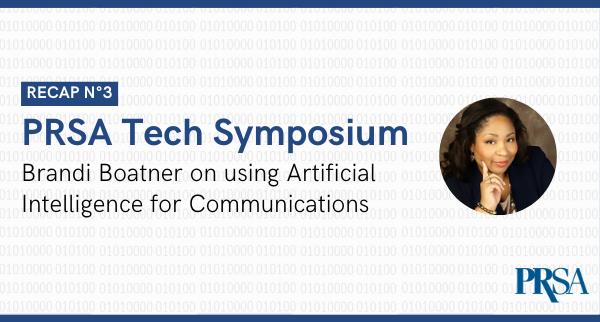
The PRSA International Conference, ICON 2020, was a virtual gathering of some of the best PR, marketing, digital and corporate communications professionals from around the world. Held in October 2020, the event’s theme, “navigating a world disrupted,” gave attendees a chance to learn about how all types of market changes—from corporate crisis to pandemics to competitive pressures—can be opportunities for learning and advancement.
Brandi Boatner, manager of Digital & Advocacy Communications at IBM, gave a history lesson on AI including where it started and how communicators can use it today in her session titled “Next Gen PR – Using Artificial Intelligence for Communications.”
Boatner started with an overview of the origin of AI, when Alan Turing asked, 'can machines think?' in 1950; and the creation of the 1965 IBM Pavilion at the New York World's Fair. Both were early examples of a desire within industry and business to automate tasks using modern forms of technology. But there’s an important difference between consumer computing and enterprise computing.
While the consumer world tends to think about mimicking speech, vision and daily interactions, the enterprise computing world is focused on mimicking and improving strategic business functions such as logistics, marketing, finance, operations and human resources.
“Enterprise AI is about solving sophisticated business problems in highly dynamic environments,” Boatner said. AI boils down into how a machine learns. But it can only learn when we feed it data. A lack of data is not the issue—in fact we are inundated with data. Digitized data is growing in volume every day. We now have more than 500 million Tweets and 300 billion emails sent, to 70 billion messages WhatsApp messages and close to 5 billion searches that are creating data daily, Boatner pointed out.
With such huge volumes of textual data created every day, there are countless insights that can be extracted to help executives and communicators make critical decisions. For example, news articles, financial reports and other sources of content can be compiled and analyzed for sentiment, helping communications teams with marketing and PR.
None of this would be possible without the help of natural language processing (NLP). “NLP is a massive space within AI, and enterprises are currently integrating NLP technologies into existing platforms more every day,” Boatner explained.
In addition, new categories of AI such as augmented intelligence are blending technology and human insight sprinkled with emotional intelligence. “Few forms of communication are as persuasive as a compelling narrative. Let the data augment your intelligence as a modern communicator so can captivate the audience’s attention,” Boatner stated.
“As PR professionals and communicators, we have a job to educate, persuade and inform on a full range of issues. These new technologies continue to change the way humans interact with each other,” she said. “Marketing and public relations professionals that adopt analytics can discover what is happening, determine why it is happening, predict what is likely to happen and prescribe the best action to take.”
Understanding this can help communications professionals target campaigns with smarter and more accurate analysis of data. For example, “what if you could create hyper-relevant personalized messages to influencers instead of using a generic pitch? PR professionals could use AI and NLP to craft a better pitch.”
Finally, Boatner defined the potential role of chatbots for communicators and talked through a process for building and testing your first bot. “Whether it’s answering questions for online shoppers, helping customers file taxes or understand insurance policies, chatbots are enhancing the consumer experience. But the experiences that you choose to enhance are entirely up to you,” she said.
Author note: Special thank you to Facundo Luque for reporting on behalf of the PRSA Technology session.